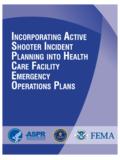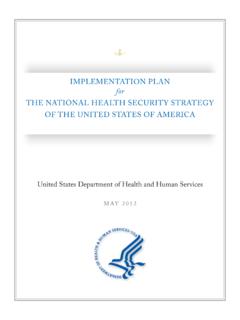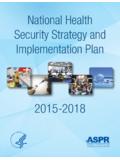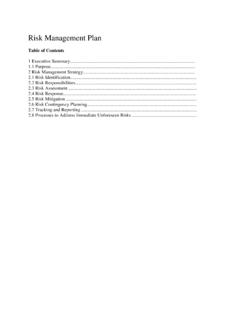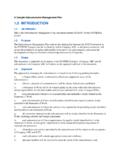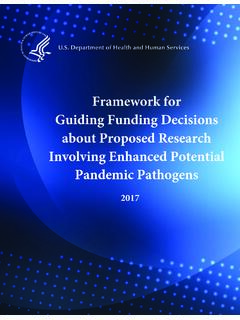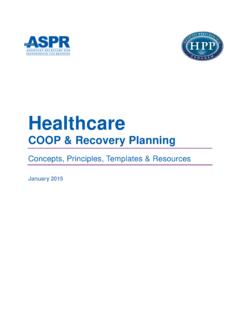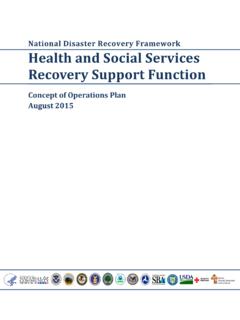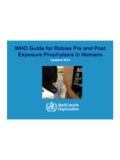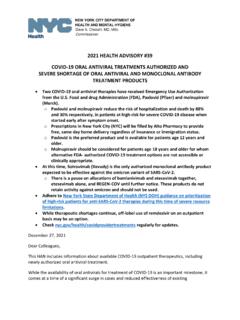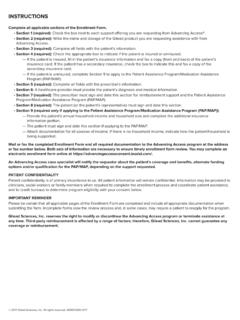Transcription of Federal Response to COVID-19: Therapeutics Clinical ...
1 Federal Response to COVID-19: Therapeutics Clinical Implementation Guide Outpatient administration guide for healthcare providers 12/29/2021. 1 Introduction to COVID-19 Outpatient Therapeutics &. Product Selection 2 Overview of Emergency Use Authorizations 3 Overview of Outpatient Therapeutic Distribution Process 4 Monoclonal Antibody Administration Table of Site and patient logistics Patient Pathways to Monoclonal Administration Team Roles and Responsibilities Contents Indications and Administration Response to Adverse Events Supplies and Resources 5 Oral Antiviral Administration Introduction to COVID-19 Oral Antiviral Therapies Prescriber Journey for Prescribing Pharmacy Journey for Dispensing Patient Journey 6 Additional Resources 2. 1. Introduction to COVID-19. Outpatient Therapeutics & Product Selection Summary of COVID-19 Preventative Agents & Therapeutics Exposed Mild to Moderate No Illness Hospital Admission ICU Admission Per CDC Close Contact Criteria Symptoms Hospitalized, Hospitalized, Hosp.
2 No act. high flow oxygen/ mechanical Baseline health status, no Not hospitalized, no Hospitalized, Hospitalized, Not hospitalized, with limitations medical non-invasive ventilation/. infection limitations not on oxygen on oxygen problems ventilation ECMO. Remdesivir Monoclonal Oral Antivirals Tocilizumab COVID-19 Paxlovid (Pfizer). Antibodies for VACCINES. PEP Molnupiravir Dexamethasone Casirivimab + (Merck). Monoclonal Imdevimab Monoclonal Antibodies for (RGN)** Antibodies for Baricitinib PrEP treatment Bamlanivimab +. Tixagevimab + Sotrovimab Etesevimab cilgavimab (AZ) (GSK/Vir). (Lilly)**. Bamlanivimab +. Etesevimab1. (Lilly)**. **Not expected to be active against omicron variant Casirivimab + NIH COVID-19 Treatment Guidelines Panel's Statement on SARS-CoV2 Monoclonal Antibodies or Remdesidivir for the Imdevimab Treatment of COVID-19 in Nonhospitalized Patients When Omicron is the Predominant Circulating Variant (RGN)**.
3 Tools to Assist in COVID-19 Outpatient Therapeutic Selection As variant prevalence changes and new Therapeutics become available, there are tools and resources available to assist in Clinical decision-making for prescribers. Clinical Decision Aid: A pathway for decision-making including outpatient parenteral and oral Therapeutics Side-by-Side Overview of Outpatient Therapeutics ( ). NIH COVID-19 Treatment Guidelines Panel's Statement on SARS-CoV2 Monoclonal Antibodies or Remdesidivir for the Treatment of COVID-19 in Nonhospitalized Patients When Omicron is the Predominant Circulating Variant ( mabs-and-rdv-and-omicron). The COVID-19 Treatment Guidelines Panel's Interim Statement on Patient Prioritization for Outpatient Anti-SARS-CoV-2 Therapies or Preventive Strategies When There Are Logistical or Supply Constraints ( ). The COVID-19 Treatment Guidelines Panel's Statement on Potential Drug-Drug Interactions Between Ritonavir-Boosted Nirmatrelvir (Paxlovid) and Concomitant Medications ( ).
4 Consider one of the following Therapeutics , if available1,2: Paxlovid within 5 days of symptom onset Adult or pediatric (age 12 and older and eGFR 60 mL/min or greater: 300mg nirmatrelvir taken with 100mg ritonavir twice daily for 5 days weight 40kg or greater) with mild to eGFR >30-<60: 150mg nirmatrelvir taken together with 100mg ritonavir twice daily for 5 days; evaluate concomitant use of CYP3A. moderate COVID-19 & high risk for inducers and medications with high dependency on CYP3A for clearance as these may be contraindicated per Paxlovid EUA. progression to severe disease OR. + sotrovimab 500 mg IV within ASAP 10 days of symptom onset (sotrovimab EUA). OR. Is Patient: Remdesivir 200mg IV x 1 dose on day 1, 100mg IV x1 on days 2-3 begun ASAP and within 7 days of symptom onset1. - Hospitalized for COVID-19 OR. - Requiring O2 OR an increase in baseline home O2. due to COVID-19. If none of the above Therapeutics are available for No patient treatment within 5 days of symptom onset No and patient is age 18 or greater Does patient have severe renal Symptom onset within impairment (eGFR <30mL/min).
5 The past 5-7 days? Yes OR severed hepatic impairment No Possibility of pregnancy, if applicable, is ruled out? Yes (child-pugh class C). No Yes Yes Symptom onset within Consider the following (symptoms within 10 days)1: the past 10 days? Yes sotrovimab 500 mg IV (sotrovimab EUA) Consider molnupiravir Authorized only in patients ages 18 and older No Within 5 days of symptom onset Molnupiravir 800mg by mouth every 12h for 5 days Treatment of symptoms, Prescribers must review and comply with the mandatory Management per NIH & requirements outlined in the molnupiravir EUA. CDC Guidelines 1 Refer to the NIH COVID-19 Treatment Guidelines Panel's Statement on the Use of Anti-SARS-CoV-2 Monoclonal Antibodies or Remdesivir for the Treatment of Covid-19 in Nonhospitalized patients when Omicron is the Predominant Circulating Variant;. Limited use of bamlanivimab/etesevimab and REGEN-COV as they Remdesivir is only approved for hospitalized individuals with COVID-19.
6 Outpatient treatment is based on information from the literature (Dec 22, 2021 Early Remdesivir to Prevent Progression to Severe Covid-19 in Outpatients; DOI: ). are not expected to be active against the Omicron variant1 2 COVID-19 convalescent plasma with high titers of anti-SARS-CoV-2 antibodies is authorized for the treatment of COVID-19 in patients with immunosuppressive disease in either the outpatient or inpatient setting (COVID-19 Convalescent Plasma EUA). mAb Susceptibility to CDC Variants of Concern Information on variants of concern updated in Section 15 of FDA fact sheets for monoclonal antibodies bamlanivimab/etesevimab and REGEN-COV are not expected to be active against the Omicron variant1; sotrovimab is expected to retain activity against omicron The CDC monitors and publishes variant information on the CDC Covid Data Tracker #variant-proportions Recommendations for Providers: If Delta still represents a significant proportion of infections locally and other options are not available, eligible patients offered bamlanivimab/ etesevimab or REGEN-COV.
7 Must be informed these Therapeutics are likely ineffective if infected with Omicron. Fact Sheet for Health Care Providers Emergency Use Authorization of Bamlanivimab and Etesevimab ( ). Fact Sheet for Health Care Providers Emergency Use Authorization for EVUSHELD ( ). Fact Sheet for Health Care Providers Emergency Use Authorization of REGEN-COVTM (casirivimab and imdevimab) ( ). Fact Sheet for Health Care Providers Emergency Use Authorization of Sotrovimab ( ). 1 NIH COVID-19 Treatment Guidelines Panel's Statement on SARS-CoV2 Monoclonal Antibodies or Remdesidivir for the Treatment of COVID-19 in Nonhospitalized Patients When Omicron is the Predominant Circulating Variant ( ). NIH COVID-19 monoclonal antibody guidelines when there are logistical constraints The NIH COVID-19 Treatment Guidelines Panel recommends using anti-SARS-CoV-2 monoclonal antibodies for the treatment of mild to moderate COVID-19 and for post - exposure prophylaxis (PEP) of SARS-CoV-2 infection in individuals who are at high risk for progression to severe COVID-19, as outlined in the FDA Emergency Use Authorizations (EUAs).
8 See the individual EUAs for details. Logistical constraints ( , limited space, not enough staff who can administer therapy) can make it difficult to administer these agents to all eligible patients. In situations where it is necessary to triage eligible patients, the Panel suggests: Prioritizing the treatment of COVID-19 over PEP of SARS-CoV-2 infection. Prioritizing the following groups over vaccinated individuals who are expected to have mounted an adequate immune Response : Unvaccinated or incompletely vaccinated individuals who are at high risk of progressing to severe COVID-19. Vaccinated individuals who are not expected to mount an adequate immune Response ( , immunocompromised individuals). Providers should use their Clinical judgment when prioritizing treatments in a specific situation. When there are no logistical constraints for administering therapy, these considerations should not limit the provision of anti-SARS-CoV-2 monoclonal antibodies.
9 2. Overview of Emergency Use Authorizations The Role of Emergency Use Authorization (EUA). 2. in COVID-19 Therapeutics Q: What is an emergency use authorization and how is it being used to respond to COVID-19. A: In certain types of emergencies, the FDA can issue an emergency use authorization, or EUA, to provide more timely access to critical medical products (including medicines and tests) that may help during the emergency when there are no adequate, approved, and available alternative options. The EUA process is different than FDA approval, clearance, or licensing because the EUA standard may permit authorization based on significantly less data than would be required for approval, clearance, or licensing by the FDA. This enables the FDA to authorize the emergency use of medical products that meet the criterial within weeks rather than months to years. EUAs are in effect until the emergency declaration ends but can be revised or revoked as we evaluate the needs during the emergency and new data on the product's safety and effectiveness, or as products meet the criteria to become approved, cleared, or licensed by the FDA.
10 About Emergency Use Autorizations (EUAs). #abouteuas Monoclonal Antibody Indications and Routes of Administration Monoclonal PRE- exposure prophylaxis post - exposure prophylaxis (PEP) for TREATMENT of Mild to Moderate COVID-19. (PREP) for eligible individuals individuals who are not fully vaccinated or Infection within 10 days of symptom onset Antibody immunocompromised, with high risk of in patient with high risk of progression to progression to severe disease severe disease bamlanivimab and Dose: bamlanivimab 700mg and Dose: bamlanivimab 700mg and etesevimab1 etesevimab 1400mg etesevimab 1400mg N/A Route: Intravenous Route: Intravenous ** ** **. (Eli Lilly). post -administration observation: 60 post -administration observation: minutes 60 minutes Weight-based pediatric (< 40kg) dosing1 Weight-based pediatric (< 40kg) dosing1. casirivimab and Dose: casirivimab 600mg and imdevimab 600mg Dose: casirivimab 600mg and imdevimab 600mg imdevimab2 N/A Route: Intravenous is preferred route, however Route: Intravenous or subcutaneous (REGEN-COV) subcutaneous injection may be utilized in situations post -administration monitoring: 60 minutes ** where there would be a delay in intravenous administration ** **.
